Select Language
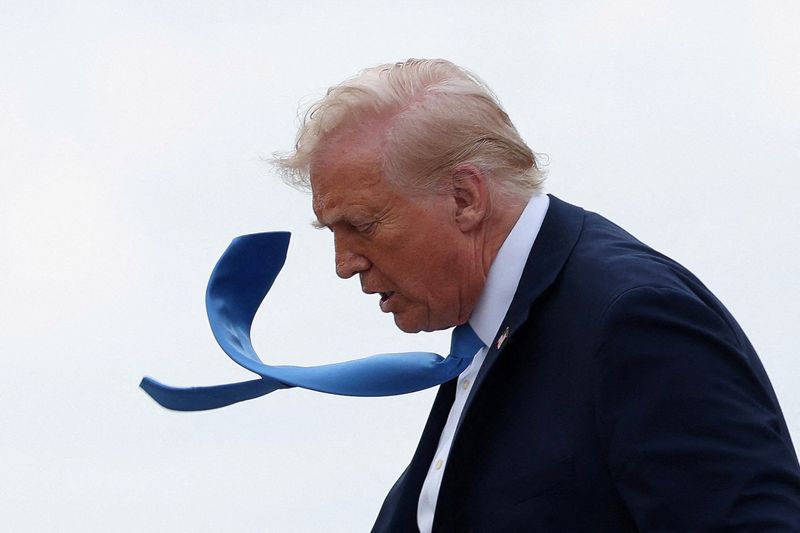
Monday’s declaration by U.S. President Donald Trump indicates a further escalation in the trade tensions between the United States and China. Trump, in a post on Truth Social media, has stated that the United States will impose an additional 50% tariff on Chinese goods if China does not rescind its recent 34% tariff hike by April 8, 2025. This ultimatum follows China’s retaliatory tariffs and other trade practices that Trump has labeled as abusive.
The new tariff escalation from Trump comes despite markets around the world being rocked by Trump’s reciprocal tarrif announcement last Wednesday. The S&P 500 lost over 10% last week since the announcement and is down another 1.8% today, accelerating losses following the social media post.
In his message, President Trump criticized China for its imposition of a 34% retaliatory tariff, which he views as an addition to its "already record-setting tariffs, non-monetary tariffs, illegal subsidization of companies, and massive long-term currency manipulation." He emphasized that any country retaliating against the U.S. with additional tariffs would face immediate and substantially higher tariffs from the U.S. in response.
Trump’s post clarified the consequences for China if it fails to withdraw the tariff increase. He stated that the new U.S. tariffs would be effective from April 9th. In addition to the tariff threat, Trump also announced that all discussions with China regarding their requested meetings would be terminated if they do not comply with the U.S. demands.
The President’s message comes in the wake of what he describes as China’s long-term tariff abuse of the U.S. He has previously warned that retaliation by any country with additional tariffs would be met with a significant response from the U.S. In his post, he also mentioned that the United States would begin immediate negotiations with other countries that have sought meetings, signaling a shift in diplomatic engagement away from China.
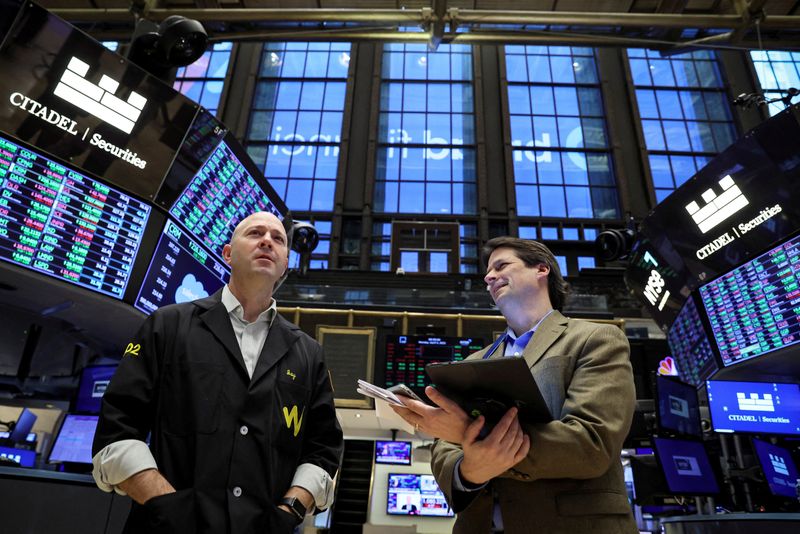
S&P 500 stocks cut some losses Monday, but ultimately ended lower after swinging widely during the session amid ongoing speculation on whether President Donald Trump will offer countries a path toward negotiating reprieves on tariffs.
At 4:00 p.m. ET, the Dow Jones Industrial Average dropped 349 points, or 1.2%, the S&P 500 index gained 0.2%, while the NASDAQ Composite added 0.04%.
The benchmark indices had opened sharply lower Monday, continuing the selloff seen at the end of last week, which had seen the broad-based S&P 500 index tumble over 10%, erasing nearly $5 trillion in market value, marking its most significant two-day loss since March 2020, the onset of the COVID-19 pandemic.
Trump reiterates no pause on tariffs; threatens to raise China tariffs following retaliation; talks to start with Japan
In a press briefing on Monday, Trump reiterated that the United States wasn’t considering pausing the reciprocal tariffs that have wrecked havoc on markets.
Earlier in the session, stock saw a brief reprieve on unconfirmed reports that U.S. President Donald Trump was considering pausing his sweeping trade tariffs for 90 days on all countries except China. The White House later debunked this as "fake news", but the short-term jump in stocks illustrates the jitteriness of the market after two brutal days of selling.
Trump, in a post on Truth Social media shortly after 11 AM ET, stated that the United States will impose an additional 50% tariff on Chinese goods if China does not rescind its recent 34% tariff hike by April 8, 2025. This ultimatum follows China’s retaliatory tariffs and other trade practices that Trump has labeled as abusive.
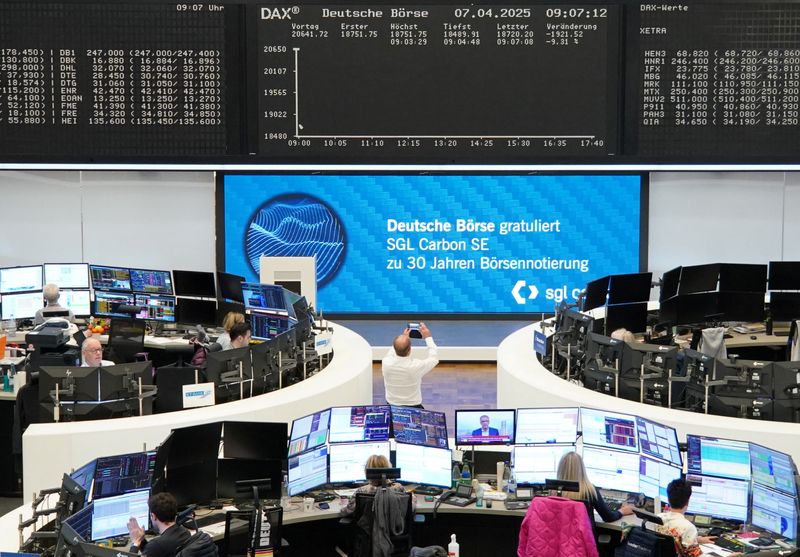
By Sukriti Gupta and Medha Singh
(Reuters) -European shares plunged to a 16-month low on Monday as investors grappled with the possibility of a recession after U.S. President Donald Trump showed no signs of letting up in his aggressive trade war.
The pan-European STOXX 600 slumped 5.8% at 0722 GMT, down for the fourth straight session and on track for its steepest one-day percentage decline since the COVID-19 pandemic.
Trade-sensitive Germany’s benchmark index dove 6.1%, among the worst hit markets in the euro area. At one point the index was down more than 20% from its March all-time closing high. The index would confirm it has been in a bear market if it closes at session lows.
Over the weekend Trump told reporters that investors would have to take their medicine and he would not do a deal with China until the U.S. trade deficit was sorted out, sparking a fresh wave of selling in Asian markets. [MKTS/GLOB]
"There was some hope over the weekend that maybe we would see the start of a negotiation, but the messages that we’ve so far seen suggest that President Trump is comfortable with the market reaction and that he’s going to continue on this course," said Richard Flax, chief investment officer at Moneyfarm.
European banks were on pace to confirm a bear market with Commerzbank (ETR:CBKG) and Deutsche Bank shedding 10.7% and 10%, respectively on Monday.
Investors also booked gains in shares of arms makers, which had surged earlier this year on prospect of higher defence spending. Tankmaker Rheinmetall (ETR:RHMG) dropped 10%, while Hensoldt, Rheinmetall and Renk fell between 8% and 12%.
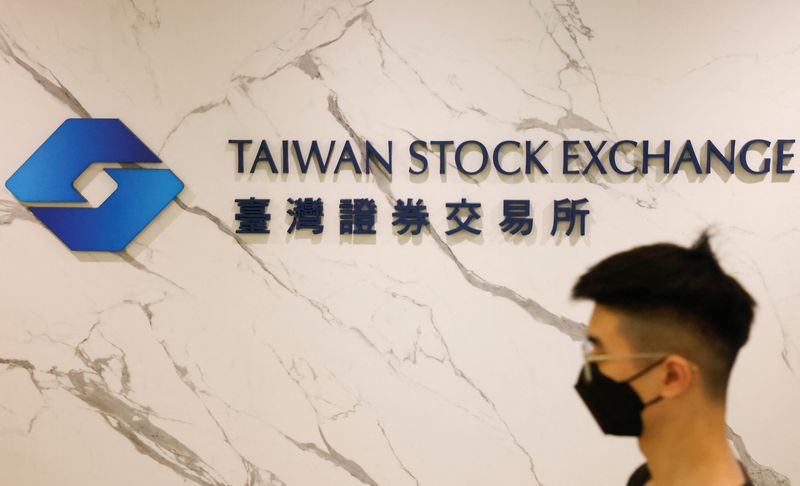
By Roger Tung and Faith Hung
TAIPEI (Reuters) -Taiwan stocks plummeted almost 10% on Monday in their first trading since the United States announced new import tariffs last week, as Taiwan President Lai Ching-te took to X to pledge in English a "golden age" of shared prosperity with the U.S.
Taiwan, hit with a 32% duty, was singled out by U.S. President Donald Trump as among the U.S. trading partners with one of the highest trade surpluses with the country.
After resuming trade on Monday following market holidays on Thursday and Friday, Taiwan’s benchmark stock index plunged to its lowest level in more than a year and its biggest one-day percentage drop since at least 1990, according to LSEG data.
Taiwan on Friday announced a T$88 billion ($2.65 billion) support package for companies hit by the tariffs, while Lai on Sunday said the island would buy more from and invest more in the United States, with the aim of a zero-tariff regime between the two.
On his X account on Monday, Lai reiterated he did not seek retaliatory tariffs and that "we’ll start talking from bilateral ’zero tariffs’."
"To ensure Taiwan’s competitiveness, we’ll increase US imports & adopt other measures. Working together, we’ll usher in a golden age of shared prosperity," he added.
Taiwan has long sought a free trade deal with the United States.
While semiconductors, Taiwan’s main manufacturing strength, are not included in Trump’s tariffs, Taiwan has a trade-dependent economy highly reliant on its part in the global electronics supply chain for everything from smartphones to cars.
Shares in chipmaker TSMC and electronics maker Foxconn (SS:601138) both fell near 10%, triggering the 10% circuit breaker in the Taiwan market. "The panic selling pressure is very high," said Venson Tsai, an analyst at Cathay Futures in Taipei. "This is a problem of market confidence."
Taiwan’s top financial regulator on Sunday announced it would impose temporary curbs lasting all this week on short-selling of shares to help deal with potential market turmoil from the tariffs.
Speaking to reporters shortly after the market opened, Taiwan Stock Exchange Chairman Sherman Lin said it would coordinate with the financial regulator to take further stabilisation steps if needed.
The stock exchange will maintain flexibility in stabilisation measures this week to handle volatility stemming from new U.S. import tariffs, Lin added.
He said it would be hard for Taiwan to escape the market impact of the tariffs, but called on investors to have confidence in Taiwanese companies and the government.
Allen Huang, a vice president of Mega Financial’s securities investment unit, said in a worst-case scenario, the chance of a recession could be higher than 50%.
"We’re not expecting Trump to change his policy in the near term," he said.
Goldman Sachs downgraded Taiwan to "underweight" in its Asian market allocations on Sunday, citing high exposure to U.S. exports and market sensitivity.
($1 = 33.2020 Taiwan dollars)
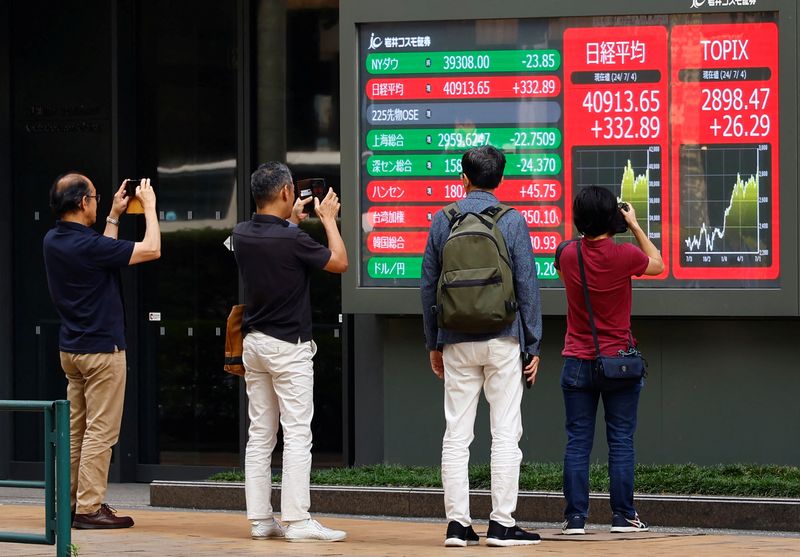
By Kevin Buckland
TOKYO (Reuters) -Japan’s Nikkei share average tumbled nearly 9% early on Monday, while an index of Japanese bank stocks plunged as much as 17%, as concerns over a tariff-induced global recession continued to rip through markets.
The Nikkei dropped as much as 8.8% to hit 30,792.74 for the first time since October 2023, before entering the midday trading recess down 6.5% at 31,591.84.
All 225 component stocks of the index were in the red.
The broader Topix sank as much as 9.6% before ending the morning session down 6.5%.
Speaking on Sunday aboard Air Force One, U.S. President Donald Trump characterized his latest round of sweeping tariffs as "medicine" aimed to rectify trade imbalances, and signalled a willingness to accept the market rout that followed.
Since Trump revealed the more aggressive-then-anticipated levies last week, the Nikkei has tumbled 11.6% and the U.S. S&P 500 has dropped 10.6%.
"It’s extremely difficult to judge how far this stock market correction will run (but) as long as there exists a lack of clarity of tariffs and each country’s response, the market will remain heavy," said Maki Sawada, an equities strategist at Nomura Securities.
At the same time, "the market currently is only pricing in bad news", so if there are signs of flexibility on tariffs or the announcement of economic support measures, "it’s highly likely we’ll see a bottom form in the market," Sawada said.
A topix index of banking shares slumped as much as 17.3% on Monday, before recovering slightly to enter the midday recess down 9.8%.
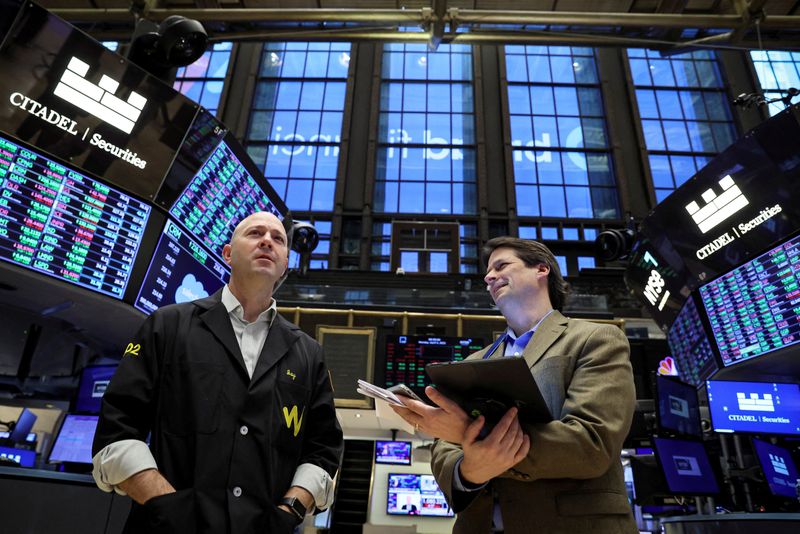
U.S. stock index futures plunged Sunday evening after Wall Street saw its steepest two-day drop in more than five years following President Donald Trump’s announcement of sweeping trade tariffs, which fueled recession fears and faced retaliation from key trading partners.
President Trump said on Sunday that his new tariffs are the only way to fix major trade deficits with China and the European Union, declaring that duties will stay in place.
Investors were worried Wall Street might log its worst one-day decline since 1987’s “Black Monday,” when markets around the world crashed on heightened risk aversion.
S&P 500 Futures dropped 4.5% to 4,892.25 points, while Nasdaq 100 Futures plunged 5.5% to 16,587.0 points by 20:02 ET (00:02 GMT) .Dow Jones Futures tumbled 3.5% to 37,191.0 points .
Trump tariffs escalate trade war; China retaliates, EU seeks unity
President Donald Trump last week announced the implementation of a 10% universal import tariff, which came into effect April 5, with additional higher tariffs on major trade partners, including China, Vietnam, Japan, and the European Union, set to take effect on April 9.
In response to the U.S. tariffs, China has imposed matching 34% duties on American goods, further intensifying the trade conflict.
The European Union is also seeking unity among its member states to formulate a coordinated response, potentially leading to additional retaliatory measures.
These developments have heightened fears of a global trade war, with significant implications for international commerce and economic stability.
US stocks recorded steepest 2-day decline since COVID pandemic
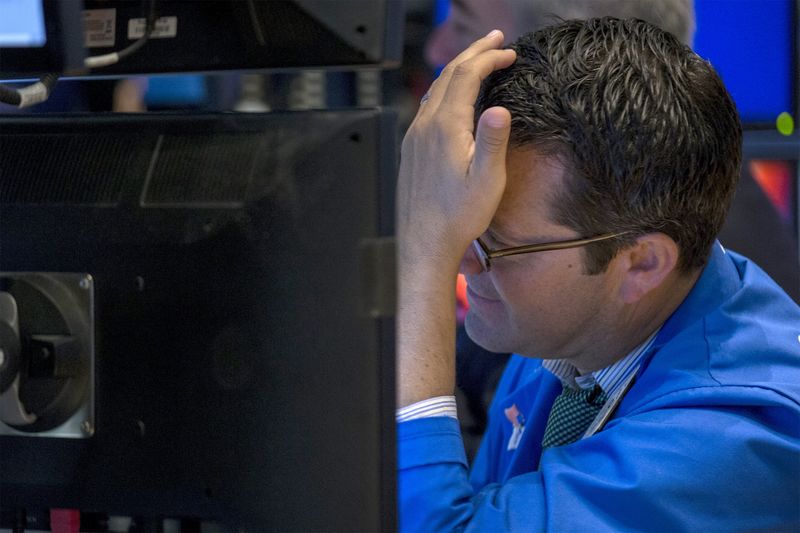
Markets enter the week on edge after a punishing stretch of tariff-driven volatility. With the first wave of U.S. tariffs taking effect Friday and more slated for April 9, investors will be watching closely for updates on global retaliation, political developments, and early signals from the corporate earnings season.
"Tariffs pose a headwind to Canadian and U.S. economic growth and put upward pressure on prices in the near term. However, the Canadian and U.S. economies entered 2025 with strong momentum," Brock Weimer, associate analyst at Edward Jones, wrote in a weekly blog post.
U.S. inflation data and a fresh deadline on the TikTok deal round out a packed week that could further increase market volatility.
1. Trade tensions escalate with tariffs set to take effect
The U.S. market selloff deepened last week as China retaliated against President Donald Trump’s sweeping 10% import taxes, fueling fears of a prolonged trade war.
The S&P 500 dropped more than 10%, marking its worst weekly loss since 2020, while global markets also posted heavy declines.
Trump’s tariffs—set to expand further on April 9—are expected to lead to a contraction in global trade, with some analysts warning of recession risks. Meanwhile, the European Union is weighing its response.
EU officials said Friday that negotiations with the U.S. were “frank,” but warned the bloc is “prepared to defend our interests” if needed.
Markets will be watching for any signs of de-escalation—or escalation—in the days ahead.
2. Trump’s social media posts continue to fuel uncertainty
President Trump continued to defend his tariff strategy over the weekend, signaling on Truth Social that he was unfazed by the market turmoil.
He claimed foreign investors were flocking to the U.S. and insisted his policies “will never change.”
While he suggested on Thursday that some countries were seeking deals ahead of Friday’s tariff deadline, Trump took a harder line on Friday morning, attacking China’s retaliatory measures.
He accused Beijing of “panicking” and reiterated his goal of stopping fentanyl shipments from China. Given last week’s developments, traders will closely monitor Trump’s feed for further updates, especially as the EU mulls its next move.
3. Earnings season kicks off with big banks
The unofficial start to earnings season arrives Friday, with reports due from BlackRock Inc (NYSE:BLK), JPMorgan Chase & Co (NYSE:JPM), Morgan Stanley (NYSE:MS), and Wells Fargo & Company (NYSE:WFC).
Retailers and airlines also report earlier in the week. Levi Strauss & Co Class A (NYSE:LEVI) posts results Monday, followed by Walgreens Boots Alliance Inc (NASDAQ:WBA) and Cal-Maine Foods Inc (NASDAQ:CALM) on Tuesday.
Delta Air Lines Inc (NYSE:DAL) reports Wednesday, providing a key look at the travel industry amid rising costs and geopolitical stress.
Still, with markets focused on Trump’s next move, positive earnings surprises may not be enough to shift sentiment if trade tensions continue to mount. Analysts warn that rising economic uncertainty from the trade dispute could weigh on investor sentiment.
4. March CPI in focus amid tariff-driven inflation fears
Thursday’s CPI report will offer a timely read on U.S. inflation as tariffs begin to ripple through supply chains.
Economists at Barclays expect the March print to be “benign and relatively unaffected by tariffs,” but warn that inflation could rise sharply later in the year due to the April 2 “Liberation Day” tariffs.
“If in line with our forecast, this could be one of the softest inflation prints we receive this year,” the bank said.
The report could influence expectations for a Fed rate cut in May, though stickier inflation driven by protectionist policy may complicate the central bank’s path.
5. TikTok Deal Deadline Extended
Trump extended the deadline for ByteDance to sell TikTok’s U.S. operations by 75 days, pushing the new cutoff into mid-June. The president said more time was needed to finalize approvals but stressed that national security concerns remain unresolved.
ByteDance confirmed ongoing talks with the U.S. government, while Amazon.com Inc (NASDAQ:AMZN), Oracle Corporation (NYSE:ORCL), and Applovin Corp (NASDAQ:APP) have all expressed interest in acquiring the app’s U.S. assets.
Trump’s latest comments also tied the deal to broader trade tensions with China, saying he hoped to continue negotiations “in Good Faith.”
Any updates on this front could add another layer of volatility to a market already rattled by geopolitical uncertainty.
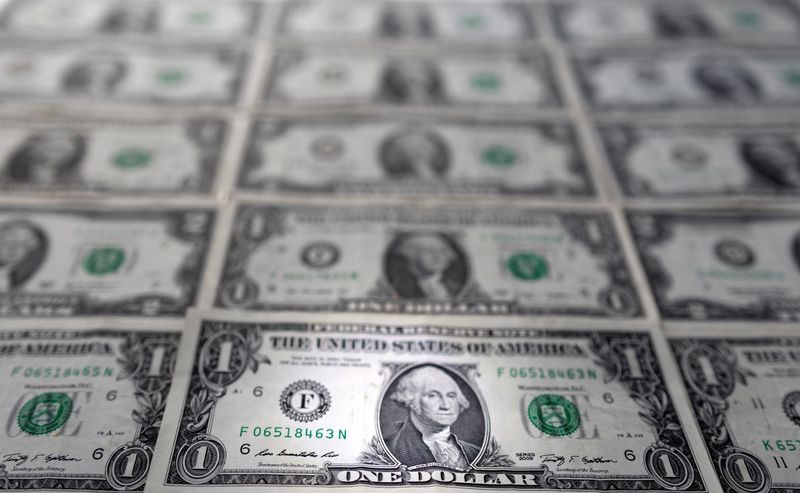
By Kevin Buckland
TOKYO (Reuters) -The U.S. dollar sank on Friday and the safe-haven yen strengthened towards a six-month peak, as traders weighed the fallout from President Donald Trump’s aggressive and far-reaching new tariff measures.
The dollar slipped toward a six-month trough against the euro prior to the release of a crucial monthly U.S. payrolls report later in the day that will offer clues to the health of the economy and the outlook for monetary easing.
Traders now predict four quarter-point interest rate cuts from the Federal Reserve in the remainder of this year, and reduced the odds of further Bank of Japan tightening to almost nil.
The risk-sensitive Australian and New Zealand dollars plunged.
Shockwaves from Trump’s harsher-than-expected tariffs were still rippling through markets more than 24 hours after being unveiled.
Stocks took the brunt of a searing selloff, driving investors to the safety of assets such as bonds and gold on fears that a full-blown trade war could trigger a global slowdown and stoke inflation.
The dollar had already been on the backfoot this year after initial euphoria over Trump’s policy agenda turned into worry that his focus on trade barriers could lead to stagflation, or even a U.S. recession.
The dollar index, a measure of the currency against a basket of six major peers, plunged 1.9% on Thursday, its worst day since November 2022, and was down a further 0.3% in the latest session.
The dollar weakened 0.31% to 145.65 yen by 0440 GMT. It slumped 2.2% in the prior session, at one point dipping as low as 145.19 yen for the first time since October 2.
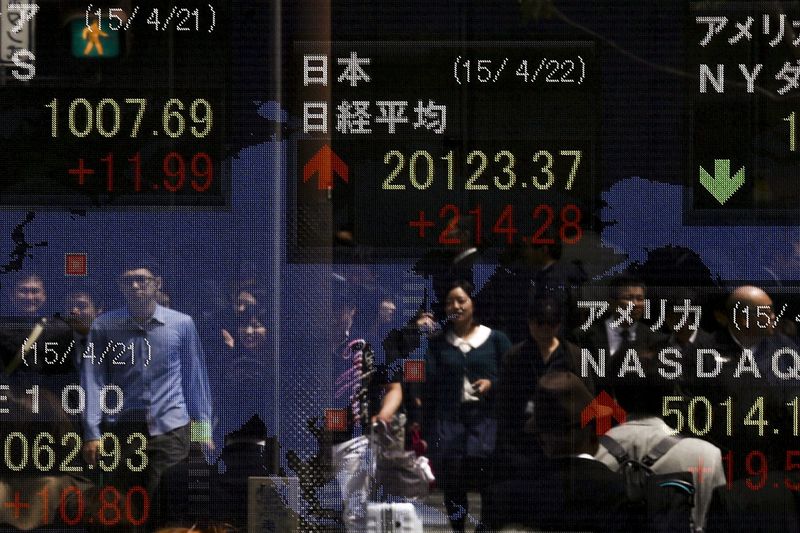
Asian stocks extended steep losses on Friday as fears of a global recession intensified following U.S. President Donald Trump’s announcement of sweeping trade tariffs.
Japan’s Nikkei 225 led regional declines, falling over 2.4%, while broader markets across South Korea, and Australia also retreated sharply.
Stock markets in China, Hong Kong, Taiwan, and Indonesia were closed on Friday for respective public holidays, contributing to thin trading volumes in the region.
Friday’s sell-off followed a dismal session on Wall Street, where major U.S. indexes plummeted.
The S&P 500 tumbled 4.8% on Thursday, its biggest one-day drop in nearly five years, while the tech-heavy NASDAQ Composite slid 6%. The sharp U.S. losses spilled over into Asian markets, as traders braced for prolonged volatility.
Asia braces for economic hit from Trump’s aggressive tariffs
Trump’s tariffs included a blanket 10% duty on all imports, alongside higher, targeted levies of up to 49% on some nations.
China now faces a combined 54% tariffs, with the 20% tariffs already in place.
Trump’s aggressive trade stance has sparked concern that global supply chains—many of which are centered in Asia—could be severely disrupted, leading to slower economic growth in export-reliant economies.
China, Japan, and South Korea, which count the U.S. among their top export destinations, could be hit hard as demand for their goods could weaken amid higher prices and retaliatory trade measures.
“The reciprocal tariff would hit Southeast Asian countries, where many Chinese companies have set up manufacturing hubs in the past few years to export to other countries including the US,” UBS analysts said in a note.
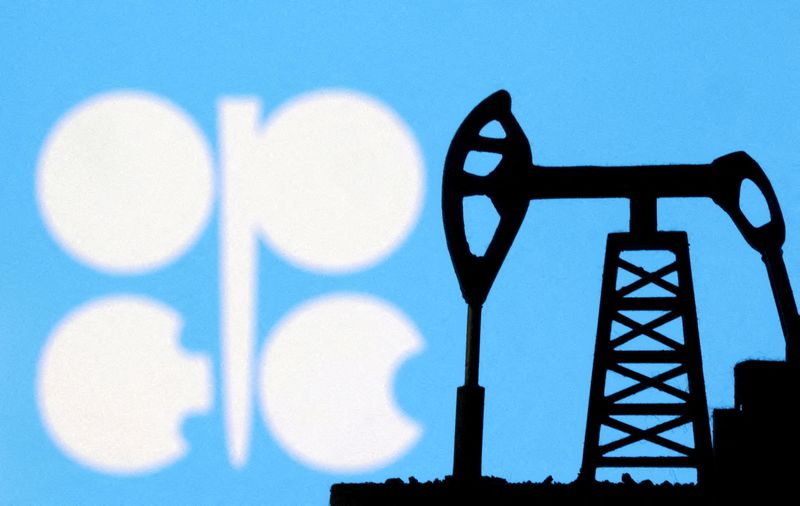
By Olesya Astakhova, Ahmad Ghaddar and Alex Lawler
LONDON/MOSCOW (Reuters) - Eight OPEC+ countries unexpectedly agreed on Thursday to advance their plan to phase out oil output cuts by increasing output by 411,000 barrels per day in May, a decision that prompted oil prices to extend earlier sharp losses.
Oil, which was already down over 4% on U.S. President Donald Trump’s announcement of tariffs on trading partners, extended declines after OPEC updated its plans in a statement, with Brent crude dropping over 6% to below $70 a barrel.
Eight members of OPEC+, which includes the Organization of the Petroleum Exporting Countries and allies led by Russia, had been scheduled to raise output by 135,000 barrels per day in May as part of a plan to gradually unwind their most recent layer of output cuts.
But after a meeting of the eight countries held online on Thursday, the group announced it would boost output by 411,000 bpd in May. OPEC cited "continuing healthy market fundamentals and the positive market outlook."
"This comprises the increment originally planned for May in addition to two monthly increments," OPEC said in a statement referring to the volume. "The gradual increases may be paused or reversed subject to evolving market conditions."
The increase will reduce fears arising from any disruption to Iranian supply as Trump restores maximum pressure on Tehran, also an OPEC member. The U.S. President, who has called on OPEC to lower prices since starting his second term, may visit Saudi Arabia as soon as next month.
The May hike is the next increment of a plan agreed by Russia, Saudi Arabia, UAE, Kuwait, Iraq, Algeria, Kazakhstan and Oman to gradually unwind their most recent output cut of 2.2 million bpd, which came into effect this month.
OPEC+ also has 3.65 million bpd of other output cuts in place until the end of next year to support the market. The total of 5.85 million bpd is equal to about 5.7% of global supply.
FOCUS ON COMPLIANCE
The decision on Thursday partly reflects OPEC+ leaders’ wish to improve compliance with production quotas, analysts said.
"OPEC+ focus is on compliance and this decision forces the laggards to step up compliance," said Amrita Sen, co-founder of Energy Aspects.
Record output in Kazakhstan has angered several other members of the group, including top producer Saudi Arabia, sources have told Reuters. OPEC+ is urging the Central Asian country, among other members, to make further cuts to compensate for excess production.
Kazakhstan has been producing oil well above the targets agreed with OPEC+ in recent months. OPEC data also shows some other OPEC+ nations such as the United Arab Emirates, Nigeria and Gabon pumping above their quotas, but by far smaller amounts.
Production in Kazakhstan could drop this month and exports could decline after Russia ordered to shut some export capacity on the CPC pipeline, the main evacuation route for oil in Kazakhstan produced by oil majors such as U.S. Chevron (NYSE:CVX) and Exxon Mobil (NYSE:XOM).
The eight OPEC+ countries will meet on May 5 to decide on June output, OPEC’s statement said.
(This story has been refiled to fix the spelling of ‘Iranian’ in paragraph 6)

